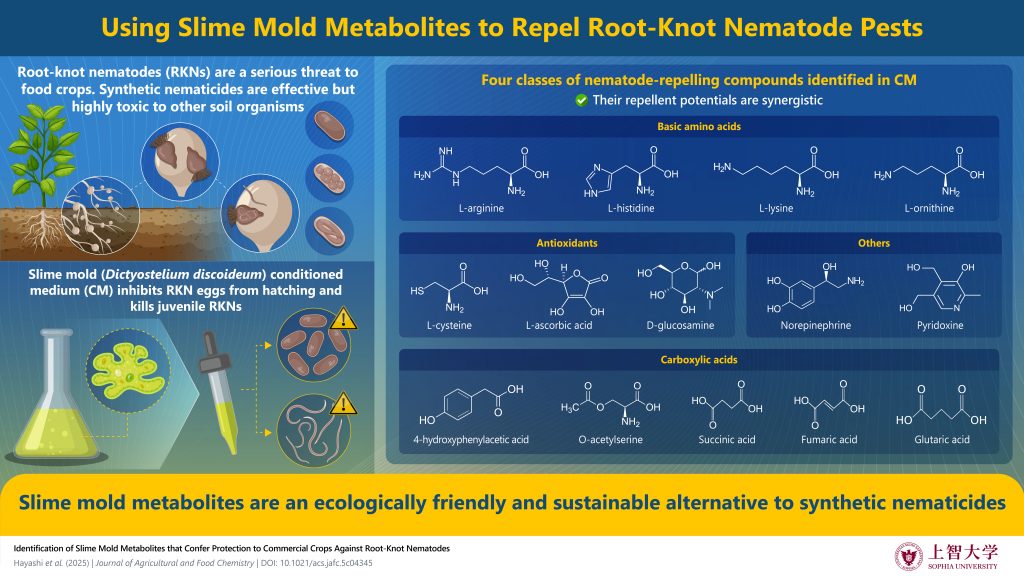Slime Mold Metabolites Are a Promising, Eco-Friendly Repellent of Root-Knot Nematodes

A team of researchers led by Professor Tamao Saito found slime mold secretes organic compounds that repel parasitic nematodes from plant roots without harming soil fertility
Root-knot nematodes cause widespread damage to crops, but chemical pesticides that control them also severely harm soil fertility. Soil-dwelling slime mold secretes compounds that repel these nematodes, but their specific nature was unknown.
Using novel culturing techniques, researchers have identified 14 compounds of high potency in repelling nematodes, paving the way for the development of non-toxic control methods.
Root-knot nematodes (RKNs) are worm-like parasites of the genus Meloidogyne that are found in many parts of the world. They attack the roots of plants, causing them to wilt and eventually die. It is estimated that crops worth nearly USD 173 billion are lost every year due to RKN infestations. While chemical pesticides are effective in controlling RKNs, they also kill other microorganisms that are beneficial to plants, thereby reducing soil fertility. New, less toxic control methods are needed to prevent the loss of crops and soil fertility to RKNs.
Cellular slime mold (Dictyostelium discoideum) is a soil-dwelling microorganism known for its ability to coordinate the activity of individual cells using chemical signals. Previous studies have shown that D. discoideum secretions can repel RKNs and protect plant roots. Understanding which of the secreted chemicals are most effective at repelling RKNs could lead to the development of new control methods.
A team of researchers led by Professor Tamao Saito from the Faculty of Science and Technology at Sophia University, Japan, has discovered 14 compounds secreted by slime molds that repel RKNs and could be the source of new, non-toxic anti-RKN pesticides. Their research was first made available online on July 29, 2025, and published in Volume 73, Issue 31 of the Journal of Agricultural and Food Chemistry on August 6, 2025.
Prof. Saito says that the aim of their research was “To enhance sustainable agricultural production by addressing the challenge posed by RKNs through the utilization of methodologies that exhibit reduced environmental impact.” Previous research revealed problems when using cell extracts from slime molds. Therefore, the current study used what Prof. Saito calls a conditioned medium (CM), where slime mold cells were collected from growth medium, suspended in buffered water for 3 days, then dried and re-dissolved for use as needed.
CM had a very strong repellent effect against RKNs. At a concentration of 30 mg/mL, CM prevented the hatching of 99% of RKN eggs and killed nearly all juvenile RKNs. Even at a 3 mg/mL concentration, 81% of eggs did not hatch, and 71% of the juveniles were killed. In addition, pot experiments with tomato seedlings showed that daily treatment with CM protected roots from heavy nematode infection for up to 2 months, while also improving aboveground plant growth.
Encouraged by these results, the team then analyzed the chemical composition of the CM. 14 distinct organic compounds were found to repel juvenile RKNs. Of these 14 compounds, four are L-type basic amino acids, five are carboxylic acids, three are antioxidants, along with norepinephrine and pyridoxine. While some compounds were less effective in soil when tested individually, the researchers found that combining them produced a strong synergistic effect. This mixture was far more effective than the compounds alone, showing real potential for use in crop protection.
The team also found that these 14 compounds had synergistic effects. 0.01 mg of the mixture of the 14 compounds was as effective at repelling RKNs as 5 mg of CM, demonstrating the high potency of the mixture. In addition, as these were naturally occurring compounds, they would have very mild effects on soil fertility if used at scale. “Repellent compounds derived from cellular slime molds can contribute to sustainable food production and improved soil health as part of an integrated pest management approach,” says Prof. Saito.
Having identified repellent compounds in CM, Prof. Saito plans to direct future research towards understanding the mechanisms of RKN repulsion. “Since synergistic repellent effects were observed when multiple repellent compounds were mixed, these compounds may enhance repellent behavior by utilizing multiple different signaling pathways,” she says. Adding that: “It is important to verify at the genetic level how repellent substances induce repellent responses in RKNs, and this is the next step of our study.”
Reference
- Title of original paper
Identification of Slime Mold Metabolites That Confer Protection to Commercial Crops against Root-Knot Nematodes
- Journal
Journal of Agricultural and Food Chemistry
- Authors
Kana Y. Hayashi1, Yukiko Nagamatsu3, Moemi Kawano1, Sayaka Fuchimoto1, Tsuyoshi Araki2, and Tamao Saito2
- Affiliations
1Graduate School of Science and Technology, Sophia University, Japan
2Faculty of Science and Technology, Sophia University, Japan
3Environmental Science Research Institute, Panefri Industrial Co., Ltd., Japan
About Professor Tamao Saito
Dr. Tamao Saito is a professor in the Department of Materials and Life Sciences at the Faculty of Science and Technology, Sophia University, Japan. She completed her PhD at Hokkaido University, where she also worked until joining Sophia University in 2009.
She has published 69 papers, articles, and book chapters. Her primary research areas are chemical biology and molecular biochemistry, with a focus on chemical ecology and the metabolism of cellular slime molds.
Funding information
This study was supported by JST A-STEP (Grant Number: VP30218088615 and JPMJTR204B).
Media Contact
Office of Public Relations, Sophia University
sophiapr-co@sophia.ac.jp